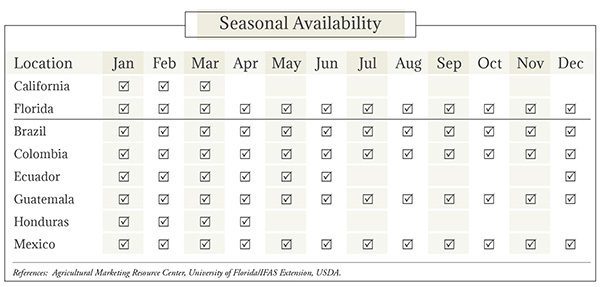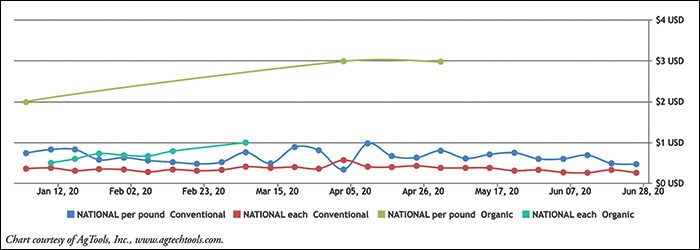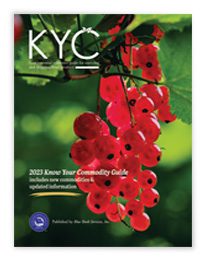Lime Market Summary


Image: Radu Bercan/Shutterstock.com
Lime Industry Overview
The lime (Citrus latifolia) was introduced to the world sometime before the sixteenth century, although its origins are very different depending on type. Arabs brought Key limes through North Africa and into Europe. Later, explorers from Spain and Portugal brought the fruit to America in the early 1500s where it became a commercial commodity by the late 1800s. Although Persian limes originated in Southeast Asia, this variety of lime was dubbed the “Tahiti” lime in the mid-1800s when it was imported to the United States from Tahiti and began to be grown in Florida and California. Prized for its taste and usefulness in seasoning and cooking, limes are also used medicinally to soothe mosquito bites, coral stings, and some oral irritations. With high Vitamin C content, limes were used in the nineteenth century to prevent scurvy. The commercial lime industry ended in the United States by the beginning of the twenty-first century due to problems with pests and disease such as citrus canker. While many countries grow limes for domestic consumption, Mexico and Brazil are the world’s major exporters.

Types & Varieties of Limes
There are two major types of lime: Mexican or Key limes (Citrus aurantifolia) and Persian or Tahiti limes (Citrus x Tahiti). Another lime, the Makrut, is less common, while slender finger limes are gaining popularity. Key limes are small and round, measuring around one to two inches in diameter. Immature Key limes are green, but gain a yellow tinge as they mature. The rind is leathery, smooth, and thin. More acidic than Tahiti limes, Key limes are seedy with juicy, greenish-yellow flesh. Varieties of Key limes include Everglade, Kagzi, Palmetto, and Yung. Tahiti limes are larger and more oval-shaped. Dark green at maturity, the fruit yellows as it becomes overripe. With only a slightly acidic taste, Tahiti limes are usually seedless with light green, juicy flesh. Varieties include Bearss, Idemor, and Pond. Makrut limes are small, dark green, with bumpy skin. Up and coming Australian finger limes are narrow and thinner, full of bubble-like capsules of juice.Cultivation of Limes
Limes require a tropical to subtropical environment in a variety of soil types. Trees need plenty of ambient heat and rainfall (between 80 and 150 inches per year) to reach maturity and thrive. Tahiti lime trees grow to approximately 15 to 20 feet tall with widely-spread, thornless branches, many of which will droop to the ground. Fruit may produce a few seeds if trees are planted among other citrus trees and flowers have no usable pollen. Bloom to maturity is between 90 and 120 days; trees reach full production after about eight to ten years. Key lime trees seldom grow more than 12 feet tall. Branches are slender and thorned. Tree varieties without thorns tend to be smaller with darker leaves and lower production. Trees are very sensitive to cold; foliage is damaged at 30 to 32°F and trees may die from exposure at 29° or below.
Pests & Diseases Affecting Limes
Pests of concern include the Asian citrus psyllid, brown citrus aphid, leafminers, red and snow scale, and red, rust or broad mites. Common diseases include algal disease, citrus canker, citrus greening, scab, foot rot, greasy spot, postbloom fruit drop, blotch disease, green and blue mold, stem-end rot, and end breakdown or rot. Overripe or roughly handled fruit is susceptible to oil spotting and stylar-end breakdown.Storage & Packaging of Limes
Limes are packed into bins in the field and transported to packinghouses for cleaning, grading, sizing, washing, waxing, and final packing in corrugated cartons for shipment. Cartons can be 10, 20, 40, or 55 pounds each. Limes can generally be kept for up to 8 weeks between 50 and 55°F with 90 to 95% relative humidity. Rates of respiration increase with higher temperatures. Key limes are best picked when their surface is smooth, color is light green and fruit feels slightly soft. Picked limes ripen quickly in warm climates but are also prone to chilling injury under about 45°F. Storage at 48°F with 85 to 90% humidity is recommended. Packing limes in polyethylene bags with ethylene absorbents will delay ripening and moisture loss during shipping. About 40% of Tahiti limes are processed for lime juice concentrate. Unusable limes are used for juice and peel oil extract. Tahiti limes do not require curing as they stay in marketable condition for as many as 6 to 8 weeks when refrigerated. References: Agricultural Marketing Resource Center, Purdue University Center for New Crops & Plants Products, UC Davis Postharvest Technology Center, University of Florida/IFAS Extension.
Grades & Good Arrival of Limes
Generally speaking, the percentage of defects shown on a timely government inspection certificate should not exceed the percentage of allowable defects, provided: (1) transportation conditions were normal; (2) the USDA or CFIA inspection was timely; and (3) the entire lot was inspected.| U.S. Grade Standards | Days Since Shipment | % of Defects Allowed | Optimum Transit Temp. (°F) |
| 10-5-3 | 5 4 3 2 1 | 15-8-5 14-8-5 13-7-4 11-6-3 10-5-3 | 48-50° |
Inspector's Insights for Limes
- Limes must have at least 75% of their surface showing a good green color; those not meeting this requirement have blanching, the result of insu?cient sunlight during growth
- Yellowing is a free-from condition defect, due to ripening and scored as a serious damage defect
- Stylar-end breakdown usually starts at the end near the base of the nipple or tip and appears as a greyish tan, water-soaked spot; it is scored as a free-from defect, as serious damage.
Lime Retail Pricing: Conventional & Organic



